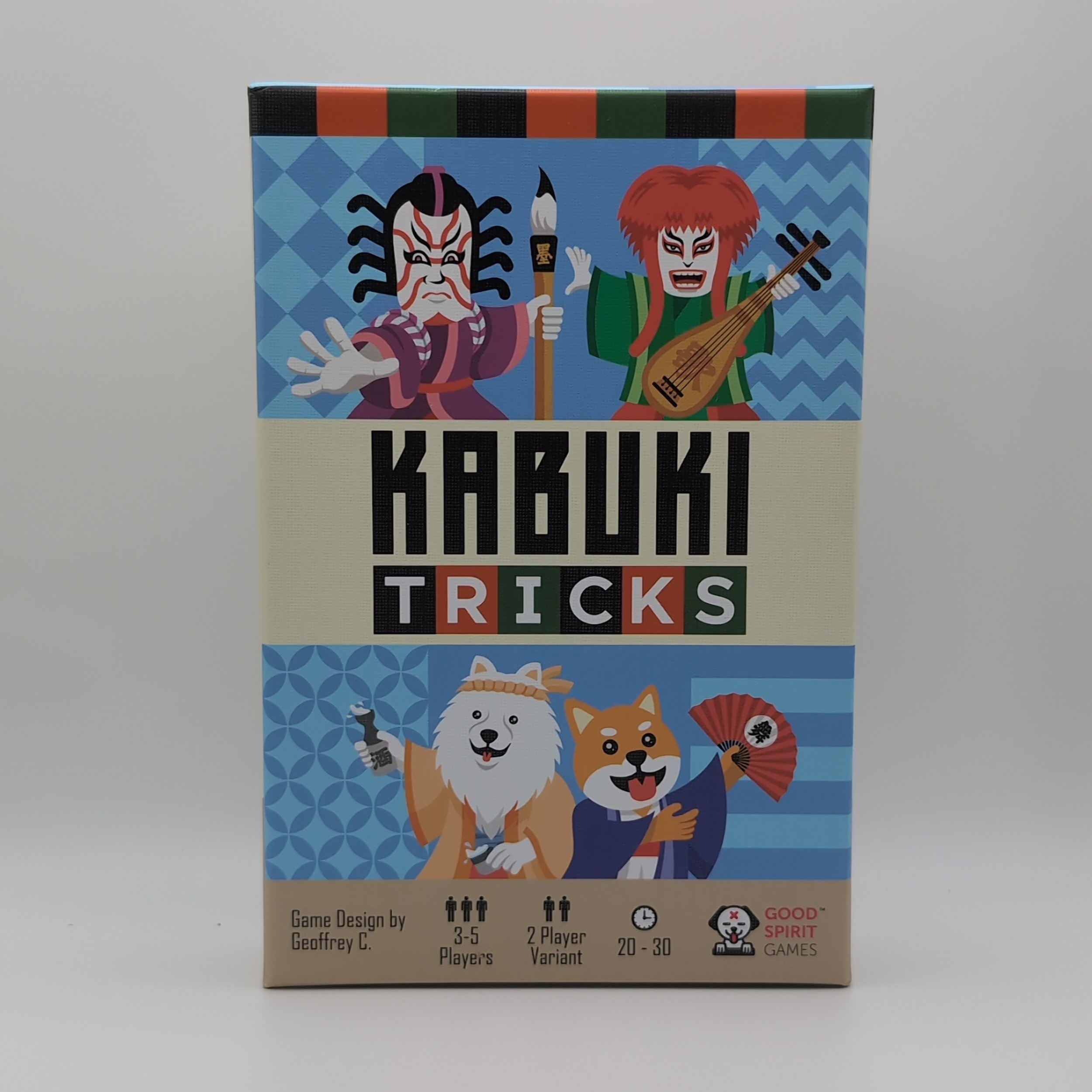Kabuki Tricks (IMPORT)
This game is from Singapore but is language-independent and English rules are provided as pdfs if they are not in the box.
It's showtime in Kabuki Tricks, with players becoming producers of Kabuki performances in which the quality of showmanship depends on the number of tricks to be won. The game is played over a number of rounds, with each player having a chance to play as the dealer. Each round plays out as follows:
• Each player gets a hand of a joker and seven random cards, which come in four actor suits. The dealer then arranges the separate actor cards in order to determine the rank of the suits, while also determining whether low or high cards are best.
• The dealer leads to the first trick, and all players must follow suit, if possible — except that one non-lead player can play their joker instead of matching suit. When someone plays a joker, they place one of their player cards face down above one of the actor cards; their player card is a bet that they will win 1, 2, or 3 tricks, and the actor they played above is a bet that their final card will be that color. Additionally, they can either flip the High/Low card to affect which numbers are best or swap two adjacent actor cards to change the rank of the suits.
• Whoever played the highest/lowest card in the highest rank wins the trick, then leads to the next trick.
• After seven tricks, players reveal their bets and score: 1 point per trick captured, 1 or 2 points for correctly bidding the number of tricks they won, and 1 point if their final card matches the actor card they chose. Alternatively, if a player's last card is their joker and they won zero tricks, they earn 5 points.
The player with the highest score after adding the scores from each round wins.
This game is from Singapore but is language-independent and English rules are provided as pdfs if they are not in the box.
It's showtime in Kabuki Tricks, with players becoming producers of Kabuki performances in which the quality of showmanship depends on the number of tricks to be won. The game is played over a number of rounds, with each player having a chance to play as the dealer. Each round plays out as follows:
• Each player gets a hand of a joker and seven random cards, which come in four actor suits. The dealer then arranges the separate actor cards in order to determine the rank of the suits, while also determining whether low or high cards are best.
• The dealer leads to the first trick, and all players must follow suit, if possible — except that one non-lead player can play their joker instead of matching suit. When someone plays a joker, they place one of their player cards face down above one of the actor cards; their player card is a bet that they will win 1, 2, or 3 tricks, and the actor they played above is a bet that their final card will be that color. Additionally, they can either flip the High/Low card to affect which numbers are best or swap two adjacent actor cards to change the rank of the suits.
• Whoever played the highest/lowest card in the highest rank wins the trick, then leads to the next trick.
• After seven tricks, players reveal their bets and score: 1 point per trick captured, 1 or 2 points for correctly bidding the number of tricks they won, and 1 point if their final card matches the actor card they chose. Alternatively, if a player's last card is their joker and they won zero tricks, they earn 5 points.
The player with the highest score after adding the scores from each round wins.
This game is from Singapore but is language-independent and English rules are provided as pdfs if they are not in the box.
It's showtime in Kabuki Tricks, with players becoming producers of Kabuki performances in which the quality of showmanship depends on the number of tricks to be won. The game is played over a number of rounds, with each player having a chance to play as the dealer. Each round plays out as follows:
• Each player gets a hand of a joker and seven random cards, which come in four actor suits. The dealer then arranges the separate actor cards in order to determine the rank of the suits, while also determining whether low or high cards are best.
• The dealer leads to the first trick, and all players must follow suit, if possible — except that one non-lead player can play their joker instead of matching suit. When someone plays a joker, they place one of their player cards face down above one of the actor cards; their player card is a bet that they will win 1, 2, or 3 tricks, and the actor they played above is a bet that their final card will be that color. Additionally, they can either flip the High/Low card to affect which numbers are best or swap two adjacent actor cards to change the rank of the suits.
• Whoever played the highest/lowest card in the highest rank wins the trick, then leads to the next trick.
• After seven tricks, players reveal their bets and score: 1 point per trick captured, 1 or 2 points for correctly bidding the number of tricks they won, and 1 point if their final card matches the actor card they chose. Alternatively, if a player's last card is their joker and they won zero tricks, they earn 5 points.
The player with the highest score after adding the scores from each round wins.

